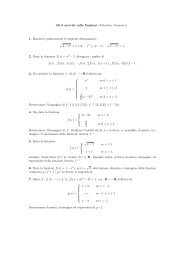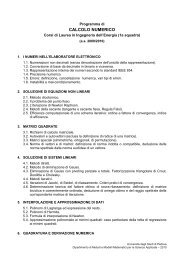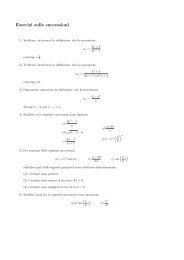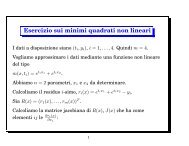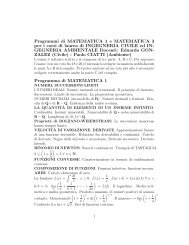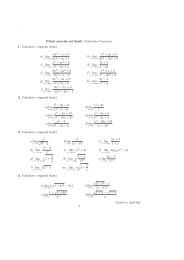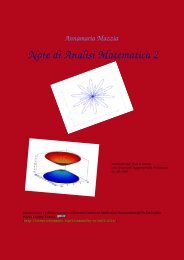Appunti di Calcolo Numerico - Esercizi e Dispense - Università degli ...
Appunti di Calcolo Numerico - Esercizi e Dispense - Università degli ...
Appunti di Calcolo Numerico - Esercizi e Dispense - Università degli ...
Create successful ePaper yourself
Turn your PDF publications into a flip-book with our unique Google optimized e-Paper software.
5.6. <strong>Esercizi</strong><br />
5.6 <strong>Esercizi</strong><br />
<strong>Esercizi</strong>o 5.6.1 Sia data la tabella seguente:<br />
x i -1 0 2 3 4<br />
f (x i ) 9 0 0 15 84<br />
(a) Scrivere la tabella delle <strong>di</strong>fferenze <strong>di</strong>vise.<br />
(b) Trovare il polinomio interpolatore (con la formula <strong>di</strong> Newton) <strong>di</strong> grado non superiore a 4.<br />
Svolgimento<br />
(a) La tabella delle <strong>di</strong>fferenza <strong>di</strong>vise è:<br />
x i f (x i ) f (·,·) f (·,·,·) f (·,·,·,·) f (·,·,·,·,·)<br />
-1 9<br />
0 0<br />
0 − 9<br />
0 − (−1) = −9<br />
2 0<br />
3 15<br />
4 84<br />
0 − 0<br />
2 − 0 = 0 0 + 9<br />
2 − (−1) = 3<br />
15 − 0<br />
3 − 2 = 15 15 − 0<br />
3 − 0 = 5 5 − 3<br />
3 − (−1) = 0.5<br />
84 − 15<br />
4 − 3 = 69 69 − 15<br />
4 − 2 = 27 27 − 5<br />
4 − 0 = 11 2<br />
11/2 − 1/2<br />
= 1<br />
4 − (−1)<br />
(b) Il polinomio <strong>di</strong> Newton <strong>di</strong> grado 4 che interpola i dati assegnati è dunque (prendendo i valori della<br />
<strong>di</strong>agonale principale della tabella)<br />
p(x) = 9 − 9(x + 1) + 3(x + 1)x + 0.5(x + 1)x(x − 2) + (x + 1)x(x − 2)(x − 3) =<br />
= x 4 − 3.5x 3 + 3.5x 2 − x<br />
<strong>Esercizi</strong>o 5.6.2 Sia data la tabella seguente:<br />
x i 0 0.1 0.8 1.2<br />
f (x i ) 1 0.48 1.32 5.32<br />
(a) Scrivere la tabella delle <strong>di</strong>fferenze <strong>di</strong>vise.<br />
(b) Usando i quattro punti in successione, scrivere i polinomi interpolanti (<strong>di</strong> Newton) p n (x) <strong>di</strong> grado<br />
non superiore ad n (con n=0,1,2,3); commentare il risultato.<br />
(c) Usando p n (x) stimare, per ogni n, f (0.6) e f ′ (0.6).<br />
(d) scrivere il polinomio p 2 (x) con la formula <strong>di</strong> Lagrange.<br />
Svolgimento<br />
81



